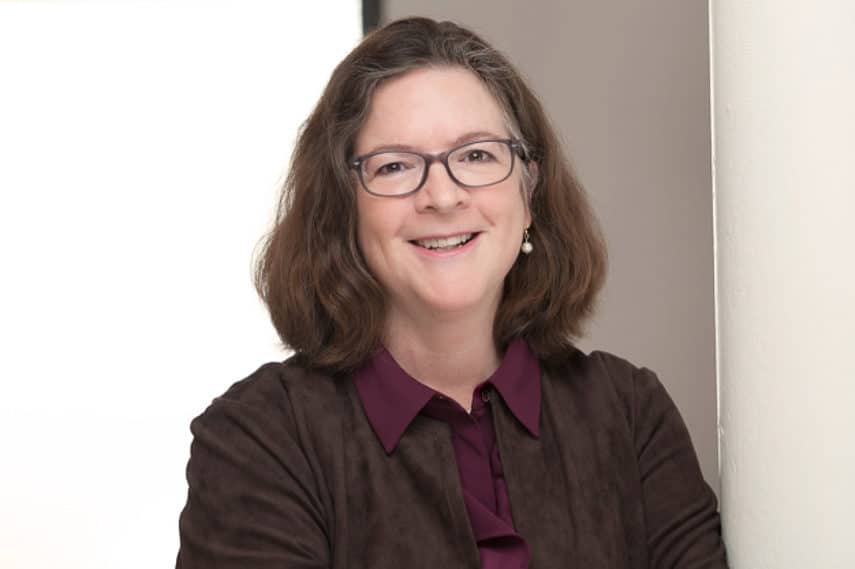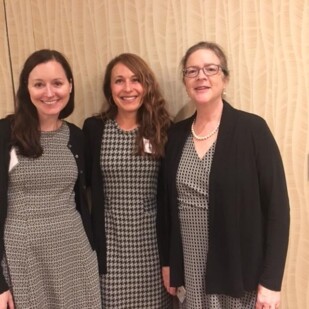Patsy Catsos from IBS-Free Joins Us for an Exclusive Interview
I first became aware of Patsy Catsos MS, RDN, LD the very same day I was introduced to the low FODMAP diet. You can read my whole story but in brief, after having lived with IBS for over 25 years, I landed in the hospital with extreme abdominal pain and the gastroenterologist on call scribbled “FODMAP” on a little piece of paper.
I started reading up on the diet from my hospital bed on my smart phone. The three sources that kept rising to the top were Monash University and Patsy Catsos, along with my book co-author Kate Scarlata RDN, LDN.
Patsy’s site, IBSfree.net, is filled with credible and useful information and her motto, IBS-Free At Last, spoke to me. I looked upon the diet as a last chance effort for me to be pain-free and her content gave me hope.
Here I got to chat with Patsy about her approach to FODMAP education, the future of those with IBS and the intersection of FODMAPs and IBD.
Dédé Wilson: Patsy! I am going to attempt to take a step back and ask you some objective questions about your part in the low FODMAP world for the benefit of our readers. Let’s go way back and tell us how you first became a RDN in the first place.
What could be a better profession for someone with my interests? I loved the science of nutrition and I wanted to be a health care provider. I was already into food and cooking, and I knew my way around professional kitchens. In fact, I was cooking in a restaurant at the age of 18. (OK, it was a small diner, but I ran the kitchen and filled all the orders single-handedly from 5pm to midnight!)
Becoming a RDN turned out to be a great choice. Here I am, many years later, still doing the things I love, learning more about nutrition science every day, and translating that science into therapies for my patient and recipes for my readers.
And how did you first learn of the low FODMAP diet?
I was attending an event hosted by the Crohn’s and Colitis Foundation of America when I heard the term “FODMAP” for the first time. It was November 2007. The presenter said that FODMAPs might be big news for people with GI problems, but she didn’t provide any details. Dédé, I have had ulcerative colitis for my entire adult life, and my pre-teen daughter had recently been diagnosed with Crohn’s disease.
“Diet as tolerated” was prescribed at that time for patients with GI problems, but I hoped for better, for us, and for my patients. I learned everything I could about FODMAPs from that day forward.
It truly takes on a new meaning when we have a personal connection, doesn’t it? As a RDN who was seeing clients regularly did it immediately resonate with you as a logical way to address IBS symptoms? Did you begin using it with your clients right away?
I loved the inherent logic I recognized in the FODMAP approach, as described by researchers at Monash University in the journal article I read. At the time, I wasn’t actually seeing any patients for IBS. There wasn’t much interest in nutrition therapy for IBS.
No wonder. The therapy of choice at the time— “eat more fiber”—didn’t work so well for most of them; it usually made their symptoms worse.
As recently as 10 years ago, IBS patients were usually told they had to learn to live with their symptoms. But some of the patients I was helping with other nutrition problems did have IBS, so in late 2007 and early 2008 I began to use low-FODMAP diets with them.
Wow! Low FODMAP diets worked! This news was too good not to share, and I soon wrote IBS—Free at Last!, the book you read (now in its third edition under the title The IBS Elimination Diet and Cookbook).
What are some of the greatest challenges that you see clients having with the diet? And what has been best tool (or tools) for you in helping your clients?
Once they start a low-FODMAP diet, the biggest challenge for my clients is time. We all know how pressed people are today, juggling work, school, child care, meal preparation and exercise.
Even flossing your teeth seems to take too much time some days! It’s not easy to squeeze in a diet project! Luckily, the right tools can help.
I make sure my clients and readers have some simple low-FODMAP menus that require minimal cooking, product suggestions, and super-easy recipes for a few hard-to-find low-FODMAP staples like a salad dressing and a marinara sauce.
I have lots of recipes and resources available for those who do enjoy, and have time for, more cooking.
As time has gone by, more people are starting low-FODMAP diets on their own, or at the behest of their doctors. What they sometimes fail to realize is that a FODMAP elimination diet is more than lists of high and low-FODMAP foods.
The challenge for these clients is that often they lack a strategy for how to learn from the diet process, and they lack a plan for moving through the steps of the diet. That is what I provide through my services and my book, always with an emphasis on what we can eat on a low-FODMAP diet.
YES! We are about thriving here at FODMAP Everyday®. We like to talk about what we can eat.
More and more lay people are hearing about SIBO (small intestinal bacterial overgrowth). Tell us about how you have used the low FODMAP diet with your SIBO patients.
Yes, SIBO has definitely captured the attention of those who suffer from digestive problems. People with IBS, by definition, have guts that don’t function right, in the absence of a specific medical explanation.
We are all eager to learn more about SIBO—some might consider it an improvement of sorts to have a treatable medical condition instead of a functional disorder.
But these are early days for SIBO. There is little science to guide practice. SIBO patients have IBS-like symptoms, so I usually treat them with low-FODMAP diets.
I do modify it based on common sense, with fewer added sugars, a longer elimination phase, and a more cautious reintroduction process.
Speaking of SIBO, do you use breath tests in your practice? Can you speak to their efficacy and also how to interpret results?
It is outside my scope of practice as a dietitian to diagnose SIBO or to prescribe antibiotics for it. I defer breath testing to gastrointestinal specialists with the credentials to diagnose.
In my practice area (Maine), breath tests are often ordered by my colleagues, and I do sometimes help patients understand their test results if they are unclear on the meaning.
You have been very open about the fact that you live with ulcerative colitis and that you have a child that was diagnosed with Crohn’s at a young age. Did you apply the diet to yourself or daughter?
Yes, and I’ll just say that we both find overdoing FODMAPs is a mistake! From the beginning, I understood that low-FODMAP diets were intended to manage symptoms for people with IBS.
But why not give IBD patients a chance to help manage similar symptoms with diet? I have never promised an IBD patient that a low-FODMAP diet can cure their Crohn’s or colitis or put it into remission.
“But I am here to tell you that symptom management can make a huge difference to a person’s quality of life.”
This will make perfect sense to anyone who has ever endured the isolating pain and bowel symptoms of IBD that make it difficult to leave the safety of home. Even when it doesn’t always seem appropriate to do a full FODMAP elimination diet protocol, I’ve observed there is a lot to be gained by identifying and eliminating top FODMAP sources in the diet during symptomatic periods.
In particular, I always take a hard look at whether my patients are using high FODMAP fluids for rehydration, and change them up if needed.
To get back to your question about my personal use of the diet, it’s been many years since I had a full blown flare of my ulcerative colitis. Like many IBD patients in remission,
I also have IBS that must be managed. I find I can liberalize my diet pleasantly during remission from my IBD. I find I can eat at least a little of all FODMAP-containing foods. Some of the foods that bother me the most if I over-do them are garlic, shallots, apples, and milk. But I sure do enjoy them in moderation!
For example, I do season food with small amounts of garlic, although I would no longer enjoy shrimp scampi or roasted garlic spread. I savored a few cappuccinos while in Italy this month, although I usually drink my coffee black. These are choices I am happy to make to feel well!
You just got back from GastroDiet 2017, held in Prato, Italy. We noticed that there was a short presentation on “The Current Status of the Low FODMAP Diet in IBD”. As someone who lives with IBD, can you bring us up to speed on where the science is now in relation to the diet?
That presentation was by Selena Cox, a graduate school at King’s College of London. Several other speakers at GastroDiet2017 also addressed the topic of FODMAPs and IBD. Studies have so far looked only at IBD patients who are in remission but continue to suffer from functional symptoms such as abdominal pain, bloating, excess gas, and diarrhea or constipation.
The gist of it is that these patients are likely to benefit from low-FODMAP diets. Though it remains to be seen which subgroups of IBD patients can benefit the most, in Ms. Cox’s latest study, it looks like patients with ulcerative colitis benefited more from low FODMAP diet than patients with Crohn’s disease.
This work is not yet published. There is no evidence so far that low FODMAP diet can reduce inflammation in IBD. When Ms. Cox gets all the inflammatory marker lab data back for the patients in her study, perhaps it will shed more light on the subject of inflammation.
Did you by any chance catch the GastroDiet presentation about “FODMAPs in Hong Kong”? We want to be a global resource to those working with the diet and would love to know what was said.
Three speakers at the symposium addressed the subject of FODMAPs in Hong Kong: PhD student Natural Chu, Dr. CK Yao, and Dr. Victoria Tan. Interestingly, functional dyspepsia (FD) is diagnosed more frequently in Hong Kong than IBS. Patients with FD have post-meal fullness and bloating, and stomach pain or burning, but not bowel problems.
There is now some evidence that low FODMAP diet can help patients with functional dyspepsia, as well as those with IBS.
High FODMAP foods consumed in Hong Kong include wheat, onion and garlic. Many traditional foods consumed in Hong Kong haven’t been tested for FODMAPs but so far it appears the usual rice-based diet in Hong Kong might be somewhat lower in FODMAPs than in Australia or the U.S.
Finally, many Hong Kong citizens follow the tenets of traditional Chinese medicine (TCM), and are far more likely to be under the care of a TCM provider than a dietitian, which will pose challenges for delivering low-FODMAP diets to this population.
What are some recent findings in relation to the diet that you are most excited about?
Dr. Marina Iacovou presented her evidence that low FODMAP diet can reduce crying and fussing in infants with colic by an average of 73 minutes per day. Although it still isn’t known how or why this happens, it is great news for parents.
If someone is reading this interview and is still suffering with IBS and hasn’t tried the low FODMAP diet, what would you tell them?
This is no mere fad. For people with functional gut symptoms, FODMAP-elimination diets offer a legitimate opportunity for relief. At first glance, when your doctor gives you that list of high and low FODMAP foods from the internet, you may think it looks impossible.
But with the right resources, you can do it! A few weeks of dietary experimentation can make a huge difference to the rest of your life.
We couldn’t agree more! We aim to make a difference in people’s lives by showing them how they CAN follow this diet – and quite deliciously! And lastly, I know you often have talks and events coming up. Anything you want to advertise in the near future? (Or we can just point to support documents on your site, etc.)
Thanks for asking! Health care providers can keep an eye on my upcoming talks and events on my website, or by subscribing to the health care provider edition of my newsletter, The IBS-Free Digest.
Along with such news, each issue of the Digest includes my blog posts from the previous month, with Q and As, recipes, or my thoughts about timely FODMAP topics. I also publish a consumer edition which you can easily sign up for from my web site, www.ibsfree.net.
I also invite people to follow me on Twitter, Instagram, Pinterest and Facebook. See you there!
Patsy, thank you so much for your time. Your contributions to the low FODMAP community, both for professionals and those with IBS, have been immense and we are all so grateful.








